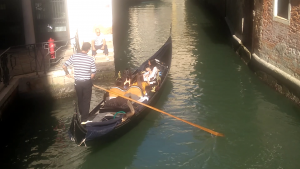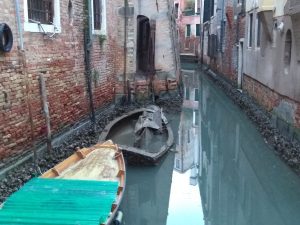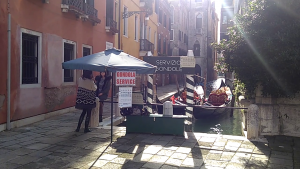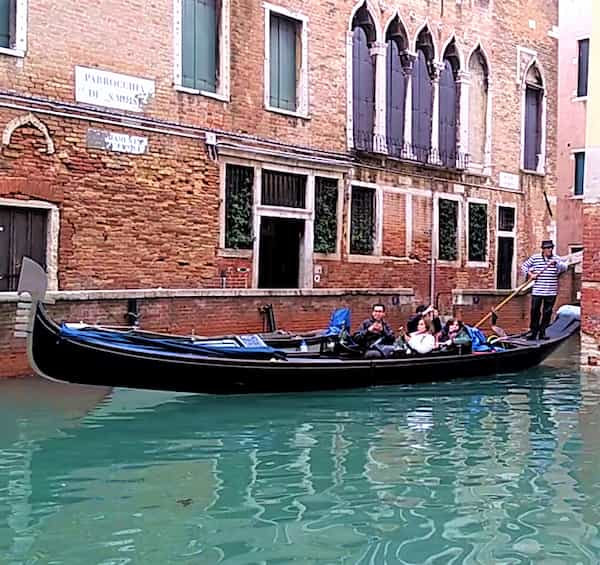How the Gondola is built
and how to ride one.

Of all the symbols of Venice, special features, and souvenirs, the most typical is the gondola. If you put a small gondola on your dining room table or you tag your letter with an image of a gondola, people will assume you’ve been to Venice. And in fact, the gondola is a boat that doesn’t exist elsewhere. The obvious reason is that the shape and structure of the boat are specialized for traveling through tiny canals.
So where does it come from?

The origin of the gondolas is the small, thin boats that filled the lagoon as far back as Roman times. The predecessor was probably a boat called scaula. It was much shorter, wider, and symmetrical. But the bloodline could have been from almost any of the many watercraft of the ancient Venice lagoon. Many of them were maneuvered with a single oar.
The name gondola was first used in 1093 A.D. In the years that followed, the typical Venetian boat slowly started to develop into a gondola-type vessel. Although it was still sort of short and chubby.
In the 16th century, the city had become a metropolis of international importance. The hundreds of narrow canals and the lively business needed faster and more flexible transports, adapted to this extreme environment. So the shape started to become longer, thinner and the extremities came out of the water. This path was continued with increasingly longer boats until in the 1800s when it reached 36 feet. But it was still symmetrical. It wasn’t until the beginning of 1900 that they bent and became asymmetrical.
And why are they all black?

Well, actually they’re not all black. But the ones in service, the tourist gondolas have to be in a dark color. It was in 1562 the Senate decided that all gondolas had to be black. Before that many families put pride in decorating their private gondolas in imaginative colors and eye-catching motifs, gold, and silver. And they did it to such an extent that the public order was at risk, and the authorities had to stop it.
The Venetian Gondola even had a cabin back in the days, the so-called felzè. This was a removable little “house” on top of where the passenger seats are. In the late 1500, there were as many as 10.000 gondolas in Venice. If you weren’t very poor or you just had to go next door, a boat was the normal way of transport. And the time it took from one part to the other of the city, was considerably long. Especially in winter when the freezing bora came down from the mountains, it must have been essential to have a refuge.

Venice has always has been a somewhat decadent city. As such, it needed spots, places where hidden meetings could take place without spying neighbors and intimidating family members. And as the city was very crowded and unwelcome attention could be all over, the gondola ride with its felzè offered privacy. In fact, the gondolier code stated that anything that happened in the gondola was kept a secret. Much like priests at confession.
How to build the gondola.
This is a problem if you’d like to try it yourself. There are no written instructions or books to consult. You have to know the trade and the only way to learn it is from a master… of which there are very few left. When Squerarolo Roberto Tramontin, the last of a long line of fine gondola-makers. passed away in November 2018 the group of people who know how to build the traditional Venetian boat diminished drastically. And since the trade is learned by hand and not by book, the future of the gondola is a little shaky.

If you still want to give it a go, first you need a good Squero. A Gondola Wharf, with a wide ramp of at least 40 feet in length. The Gondola is 36 feet long. Then you need a lot of tools, many of which are specialized for this kind of work. Then you need the wood… There are eight kinds of wood used when building the boat, cut into 280 pieces. The sides are of oak, which is strong and resists bumps and contacts with other boats and the stone quay. The bottom is made of fir which is light and runs well in water. Then there is cherry, larch, walnut, linden, elm, and mahogany. This last one is because mahogany is free of knots. It can be made in very large planks, perfect for the bow.
As you see it’s a very specialized line of work and the result is at best a piece of art unique by its beauty and functionality.
When you’ve finished with the actual Gondola, there are all the extras, just as important as the wooden structure.
First, there are all the chairs and fabrics inside, often made of very exclusive materials, colorfully painted in gold, red, blue, or any other dye chosen by the owner.

Then there is the Ferro, the iron, a large and heavy piece of metal, usually stainless steel, sticking up in the bow. It is cut in a specific manner and the form symbolizes a long list of different parts of Venice and the Venetian lagoon. The practical purpose though is to form a counterweight to the gondolier standing in the stern.
After that, maybe the most important piece of them all, la Forcola, the oarlock. This is a piece of wood, usually of walnut, very strangely formed with all kinds of odd bends and twists. It permits the boatman to use the oar in an infinite variety of positions. The whole idea of rowing the gondola is to put the oar in the various curves of the Forcola. And then take a step forward, to the side or backward. You drive the gondola with the position and weight of your own body and the position of the oar. This way the thrust is maximized and the effort is minimized. And the control is millimetric.

The Forcola is personal and cut individually to fit the gondolier’s length and body stature. There is a square hole in the gunwale where it fits and you can see all the gondolas parked and not in use missing this piece. When the gondolier arrives to start his shift, he undresses the vessel, sticks the Forcola in its place, and then he’s ready to go.
Ok, maybe that’s a bit too much to ask…
I mean to build one yourself. Another option is to order one from an existing Squero. But as I said before, there aren’t many left. It will take a year to finish and the price tag starts at 30.000 euros.
The most famous is maybe San Trovaso. Mostly because it’s close to the main tourist tracks and you can get a perfectly clear view from the other side of the canal. This Squero you can also visit if you gather 25 people and you get an appointment.

Then there is Tramontin & Figli. After the tragic death of the Maestro Squerarolo Roberto Tramontin, the business has been taken over by Matteo Tamassia. Together with Robertos daughter, Elena, they have decided to carry on the tradition. We can only wish them Good Luck. That’s the kind of spirit we need.
On Giudecca, we have Squero Crea with the owner Gianfranco Vianello. He was the latest to win the title “Re del Remo”, King of the Oars. He won the Regata Storica not only five times in a row, which is the requirement for getting the label, but seven times from 1977 to 1983. Only six rowers from 1841 until the present have gained the title.
Also on Giudecca, there is Squero del Rossi Roberto.
And if I just want to ride one?
Then you can skip the idea of building one altogether. Just rent a Gondola for a nice ride on the canal with your friends and family. If this is your choice just step up at any of the Gondola-stations and get aboard.

The price for a Gondola ride is standard and you will not be able to negotiate. At least not to any considerable level.
A 30-minute ride in the daytime will cost you 80 euros. At night, from 7 pm to 3 am the price is 100 euro for 35 minutes. It’s not cheap but considering that you can go in 6, then the price per person is less than 14 euro. And suddenly it’s not so expensive anymore.
The ride is from the starting point, the gondola station, and back to the same place. It’s a standard route. Having said this you should take care when you choose where to start. If you want to go on the Canal Grande then you should choose a station on the Canal Grande. I usually advise friends and travelers to go on the small canals. It’s much nicer to ride through the narrow turns and bends in a hidden waterway between old palaces and brick walls overhung by ancient fruit trees, than going on the bustling and noisy Grand Canal, but that’s just my point of view.
If you want more than 30 minutes, then you have to start negotiating. Normally you still have to respect the 30 minutes rule. That means 60 minutes, 160 euro, 90 minutes 240 and so on. But if you get more than one gondola and you get them for a longer trip and maybe it’s November and cold, then you can lower the price a bit.
La Serenata, a romantic experience on the Gondola
There’s also the possibility to rent a singer and a guitar player or, even more, according to the tradition, an accordion. This would be the classical Serenata. The two will cost you around 120 euro. If you want only the guitar or just the singer (… without the accompaniment. I wouldn’t recommend that. It’s like having cream without the pie.), then it will still cost you 100-ish. If you go for this option, it’s a good idea to go to the bigger stations, the biggest of them all being at Fondamenta Orseolo right behind Saint Marks’ square.
Things to watch out for 1:
There are still some gondoliers who would try to rip you off. But the problem is much less nowadays since the prices are imposed by the city and not free to set by individuals. If you book a gondola from your hotel or from some tourist agency or from one of the many websites offering gondola tours, often with a price per person, then you’ll pay more. There is no way around that. The cheapest ride you will get directly from the gondola station.

And booking upfront, when you can see the Gondola and the Gondolier has its advantages. You can more easily choose where to start when to go, and most importantly, with whom… Because some Gondoliers are nicer than others.
Things to watch out for 2:
Since the price can’t be altered, some gondoliers would give you 26, 27 minutes instead of 30. It’s already calculated a small variation depending on traffic and weather but you could let him know, in a friendly tone, that you expect 30 minutes and no less.
If you want a gondola ride you should get a gondola. Because there are also the Sandolo offering tours. This is a different boat. It’s equally nice and the price and length are the same but it’s not a gondola. I will not say that one is better than the other but you should know that if you want to say back home that you took a ride in a gondola in Venice, then you can’t if you didn’t if you know what I mean.

Sandolo to the Right
And if you would like to try and row the Gondola yourself?
This trick is a very cool alternative to just sit and enjoy the ride without moving a muscle. You can actually row the boat yourself. I don’t write row the Gondola because they’re not actually Gondolas but Sandalo-style vessels called Batela coda di Gambero, the shrimp-tailed boat.
Anyway, you can book a lesson of 90 minutes for two persons and pay 85 euro. If you’re an active person, this could be a lot more interesting. You get an idea about the rowing technique, you get some exercise, you meet a teacher who actually interested in teaching you about the boats, Venice, and its history. Row Venice is a non-profit organization offering all this. Just book and go.
The Traghetto

And lastly, a trick for those of you who desperately want to ride the Gondola just to be able to tell them at home that you did. But you can’t afford 80 euros.
For 2 euro you can go from one side of the canal to the other. It’s called Traghetto. It’s just a few minutes, and you’ll have to stand together with up to twelve other passengers. It’s not something you do for the romantic feeling or for an incredible experience… But it is a Gondola, and you will be able to tell them back home that you went on one.
These are the spots where you can find the 2-euro Gondola. Daytime only.